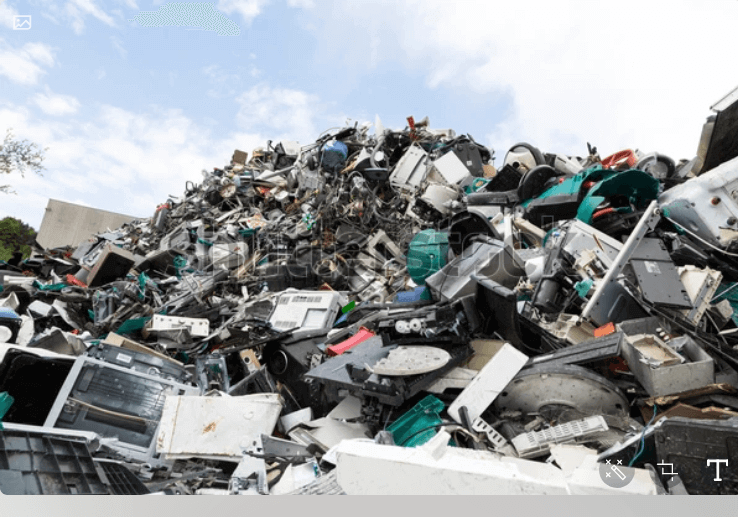Electronic waste, commonly known as e-waste, is quickly growing into an ecological catastrophe of startling proportions. E-waste is the improper disposal of any products that use electricity. That includes servers, storage devices, networking equipment, battery backups, and other hardware you’ll find in data centers.
When these devices are thrown out instead of recycled or reused, they end up in incinerators or landfills. Electronics notoriously contain some of the highest concentrations of toxic materials. These seep into the ground, water, food supply, and, ultimately, people’s bodies.
Electronics have become such an integral part of society that we’re not about to eradicate the e-waste problem entirely. Nonetheless, if we’re smart about it, we can at least take steps to substantially reduce e-waste and improve the health of people and the planet.
The E-Waste Problem

The e-waste problem happens through the accumulation of many small bad decisions. It may seem innocuous enough to throw away that one broken part, but multiply this by millions of data centers, and suddenly we have a global emergency on our hands.
For instance, more than 50 million tons of e-waste were produced last year. In fact, a single plant processes millions of pounds of discarded electronics each month. E-waste is the fastest-growing solid waste stream on the planet.
One alarming e-waste issue is that throwing away servers exposes sensitive data. Criminals in countries that receive e-waste have found important information by snooping through discarded storage devices from wealthier countries.
Part of the problem is the ongoing drive to have the latest features. Data centers frequently purchase new equipment and discard old equipment, even when the old equipment still works. Some have accused manufacturers of pushing rapid obsolescence to speed up sales. Even without this, however, there’s pressure in the highly competitive tech industry to upgrade to the newest devices with faster performance and more features.
The United Nations has estimated that less than a quarter of U.S. electronics get recycled. Sadly, most data centers don’t have recycling programs, which contributes to the problem. In some states, it’s illegal to throw electronics in the garbage, although other states do allow this. Of course, people don’t always adhere to these laws.
Some geographical areas have laws requiring manufacturers to run recycling programs, but, again, this doesn’t apply everywhere. However, a few companies are making voluntary efforts to prevent their products from becoming e-waste.
Ways to Minimize E-Waste

The good news is we’re not helpless in the fight against e-waste. There are several easy actions anyone can take right now. If we all do our part, we can minimize e-waste and make our data centers and our planet cleaner.
One way you can decrease e-waste is by recycling old equipment instead of throwing it out. If you’re unsure how to recycle these items correctly, there are organizations that specialize in recycling electronics. Also, repurposing or reselling hardware will keep it out of e-waste streams.
In the long run, better product designs can minimize e-waste. While this isn’t an action with immediate payoff, you can consider it the first step toward future improvements. For example, some manufacturers are working to make their products safer, longer-lasting, and easier to repair or recycle. If you see any of these products, buying them will improve the situation.
One of the better ways you can minimize e-waste is to use environmentally sustainable cooling. Green Revolution Cooling’s (GRC) liquid immersion cooling system coats electronics in a protective fluid that extends their life. This reduces the amount of broken hardware that gets thrown out.
Furthermore, immersion cooling places far fewer demands on electrical infrastructure. You don’t need the same number of generators and battery backups, so you’re massively downsizing your use (and waste) of electric components.
There are other environmental advantages to immersion cooling. Since it uses less electricity, there’s less pollution, fewer carbon emissions, and less water waste. All this complements the reduction in e-waste that you’ll see with liquid immersion—plus, you’ll cut your total costs in half.
Run a Green Data Center
Minimizing e-waste is just one part of broader efforts toward sustainable computing. The more steps you take to develop green data centers, the better off we all are. Customers will appreciate your efforts, and regulators may soon demand it.
Running a green data center gives you a competitive advantage. Plus, it’s the right thing to do. When you improve your power usage effectiveness (PUE), carbon usage effectiveness (CUE), and water usage effectiveness (WUE), you’re enhancing operational efficiency. It’s good for your bottom line and your reputation.
There are multiple approaches to running a green data center, and you can combine them to suit your unique situation. For instance, energy-efficient processors are a wise investment. It’s also valuable to find and responsibly eliminate old servers that are using electricity but not serving customers.
Of course, one of the easiest and most effective ways to run a green data center is to use GRC’s liquid immersion cooling system. Remember, this cuts e-waste, carbon emissions, and water use, all while costing less, so there’s really no excuse not to make the transition.
Cut the E-Waste With GRC
E-waste has become a massive problem for data centers and society. We all contribute to the problem if we dispose of electronics inappropriately, but we can all contribute to the solution by minimizing e-waste.
Maintaining parts carefully, recycling instead of trashing, and using the protective benefits of liquid immersion cooling can all go a long way toward keeping electronics from becoming e-waste. Each of these steps is manageable and can even be profitable.
Let’s join our efforts to run cleaner, greener data centers. A little bit of care now will prevent a lot of environmental problems later. It’s in everyone’s interest, especially those with data centers, and it can be as easy as upgrading to the coolest tech in town. Talk to GRC now about how we can make your data center green and reduce your e-waste.



